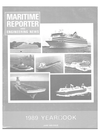
Page 94: of Maritime Reporter Magazine (June 1989)
Read this page in Pdf, Flash or Html5 edition of June 1989 Maritime Reporter Magazine
ELECTRONICS
UPDATE
Furuno Offers New Radar
For Workboats, Smaller Vessels —Free Literature Available—
Furuno recently introduced what the company says is one of the finest small dome antenna radars ever in- troduced on the U.S. market, the
Model 1830. This new radar, replac- ing the well-known M1800, has such performance features as full 3-kw output, a large, bright, high-resolu- tion 10-inch rasterscan display, high definition four-level quantization,
Furuno's exclusive MIC receiver, off-centering for forward range ex- tension, Echo Plot to assess course and speed of other targets, and trackball-controlled EBL, EVRM, cursor and Guard Zone.
The M1830 provides eight range
When the U.S. Navy needs freshwater equipment, they choose Aqua-Chem. Our rugged, reliable systems are aboard sub- marines, destroyers, mine sweepers, carriers and auxiliary ships. So when you need fresh water, count on the company with over 30 years of naval experience. Aqua-
Chem. We'll provide quality equipment with the latest proven technology. Call
Ralph Gladbach at 414-962-0100.
All-electric reverse osmosis unit for DD 978 destroyer. Developed under a research development contract. 12,800 gpd. Successfully passed shock, vibration and EMI tests.
Vertical vapor compression distilling plant for SSN 688 Class submarines. 1,600 gpd. All electric.
Submerged tube distilling plant for
MCM 1 Class mine sweeper. Nonmagnetic
Circle 297 on Reader Service Card i i
I scales from 1/4 to 24 n.m. and has a newly designed lightweight dome antenna for easy installation. When connected to an external nav receiv- er, the M1830 displays position in
Lat/Lon, vessel speed and range/ bearing to a selected waypoint at the bottom of the CRT. Also, all radar system settings and control readouts are displayed.
Furuno's new M1830 has the styl- ing, performance features and reli- ability to make it the perfect radar for yachts, smaller fishing vessels and workboats. It operates from a universal 10.2 to 40 VDC power source and requires just 50 W.
Furuno's new small dome antenna radar,
Model 1830.
For free literature containing full information on the new Model 1830 small dome antenna radar from Fu- runo,
Circle 12 on Reader Service Card
New Lifesaving Equipment
Rules Proposed For Large
Commercial Ships
The Coast Guard recently an- nounced proposed changes in the regulations for lifesaving equipment on large commercial ships. The pro- posed regulations are the result of recent revisions of an international plant which has passed vibration and shock testing. 3,000 gpd. 3-stage flash evaporator for LSD 41
Class. 30,000 gpd. Successfully passed shock testing.
WATER TECHNOLOGIES
DIVISION aqua-cheminc
P.O. Box 421, Milwaukee, Wl 53201.
Telephone (414) 962-0100. Telex: 2GG79AQM MIL. a
THE OCEAN'S KINDEST RIDE
The only ocean coastal ferry to prevent seasickness & to sustain high speeds into degraded seas
WTM 979 G Street, Chula Vista, CA 92011 Tel: (619) 426-2179 or 756-3082 Fax: (619) 426-2196 or 756-2980
Circle 308 on Reader Service Card treaty known as the Safety of Life at
Sea Convention, or SOLAS.
The proposed rules would also carry out a number of recommenda- tions that resulted from marine cas- ualty investigations by the Coast
Guard and the National Transpor- tation Safety Board. Lifesaving equipment regulations for Great
Lakes ships and other ships in domestic trade that are not covered by SOLAS would also be revised to require more effective lifesaving de- vices.
Under the proposed regulations: • Large commercial ships operat- ing in the ocean or on the Great
Lakes would be required to carry a new type of Emergency Position In- dicating Radio Beacon (EPIRB) that operates on a worldwide satel- lite frequency. EPIRBs alert the
Coast Guard and other foreign search and rescue forces to a vessel casualty, and provide a homing bea- con to locate a vessel in distress.
The new satellite EPIRBs would be phased in over a six-year period. • Ferries and passenger ships operating in water below 59 degrees
F would have to carry lifeboats or rafts to keep all survivors out of the water. • New large passenger ships in ocean service would be required to have partially enclosed lifeboats with rigid canopies at each end, and an open area in the center that can be quickly closed with a foldable cover. • Totally enclosed lifeboats would be required on most new large cargo and tanker ships.
The proposed regulations would also allow the use of some new life- saving systems, including free-fall lifeboats, marine escape slides, and inflatable buoyant apparatus.
The Coast Guard's proposed reg- ulations were published in the April 10 issue of the Federal Register, with a four-month comment period.
Comments should be submitted to:
Coast Guard Marine Safety Council (G-LRA-2), 2100 Second Street
S.W., Washington, D.C. 20593- 0001.
Copies of the proposed regula- tions may be obtained by writing to:
Coast Guard Survival Systems
Branch (G-MVI-3), 2100 Second
Street, S.W., Washington, D.C. 20593-0001. Requests may also be made by facsimile at (202) 267-1069 (24-hour automatic operation) or by telephone at (202) 267-1444.
Jarrell Named VP, General
Motors, And General
Manager Of Electro-Motive
John W. Jarrell, previously general director of the Diesel Divi- sion of GM of Canada Limited, has been elected a vice president of
General Motors Corporation and general manager of the Electro-Mo- tive Division (EMD).
In September 1985, Mr. Jarrell was appointed general director of
GMC Coaches in Pontiac, Mich. He served in that capacity until August 1987, when he was named to the position of general director for Die- sel Division, General Motors of Can- ada Limited.
Vertical vapor compression distilling plant
All-electric reverse osmosis unit 3-stage flash evaporator 98 Maritime Reporter/Engineering News

 93
93

 95
95
